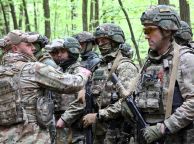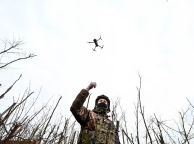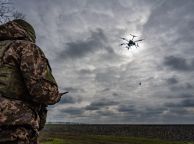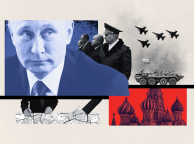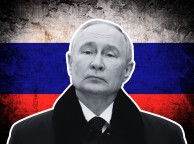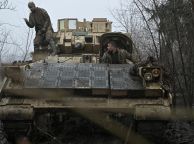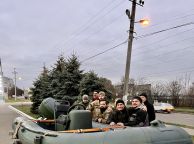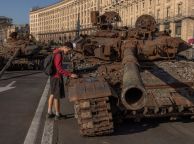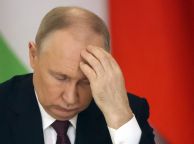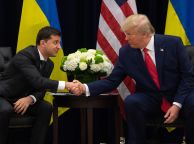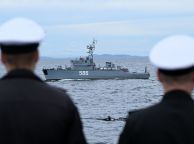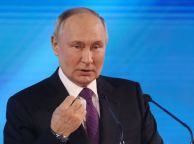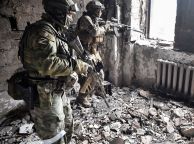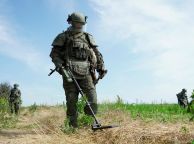By Brendan Cole
Russia's capture of Avdiivka has been followed by continued gains by Moscow in Ukraine, as concerns grow about continued United States support for Kyiv's forces, who one military expert told Newsweek are "both outmanned and outgunned along the front."
Russian forces have maintained momentum after Ukraine's retreat from the Donetsk town on February 17 which was partly blamed on ammunition shortages.
Moscow's advances since then have been incremental and are unlikely to be rapid in the short-term but hold-ups in Western aid for Kyiv threaten to hand Vladimir Putin the initiative.
The Institute for the Study of War said Tuesday that Russian forces are exploiting tactical opportunities opened up by Avdiivka's seizure and are trying to push as far as possible into the surrounding area before Ukrainian forces establish more cohesive defensive lines.
The previous day, Ukrainian Tavriisk Group of Forces spokesman Dmytro Lykhovyi said his troops had withdrawn from Stepove, around eight miles north of Avdiivka. Meanwhile, Russian sources have claimed Moscow's seizure of Tonenke to the south and other surrounding areas.
The Washington, D.C. think tank's latest maps on Tuesday show Russian advances in other parts of Donetsk oblast, namely west of Bakhmut, and in nearby eastern and central Ivanivske.
"Avdiivka was a pyrrhic victory but a victory nonetheless. The ground behind it is flatter and the breaching of this stronghold calls into question Ukraine's overall strategy amid the hold-up in U.S. Congress," said Zev Faintuch, senior intelligence analyst at security firm Global Guardian.
The U.S. Senate supported a $95 billion aid bill for Ukraine, Israel, and Taiwan on February 13, with over $60 billion allocated for Ukraine. However, it still needs approval from the U.S. House of Representatives.
"If the aid bill isn't passed soon, there will be more Avdiivkas as Russia tries to seize the opportunity to cement its gains in Donetsk," Faintuch told Newsweek.
Ukraine's Defenses
Military analyst Mike Kofman, a senior fellow at Carnegie Endowment, told the War on the Rocks podcast that Ukraine "does not have good secondary lines" and was "quite behind in entrenching across the front."
"Behind Avdiivka, Ukraine has some defenses, but it is not a strong line," Kofman said on February 24. "The Russian military may run out of momentum, but on the other hand if they are able to fully sustain these offensives pushes over the coming year, then eventually they may find more and more open terrain," which could lead to a "potentially slippery slope."
This week, Zelensky revealed for the first time Kyiv's official figure of losses, saying that 31,000 Ukrainian troops had been killed, although other western estimates put the tally much higher.
Ukraine's decision out of demographic and economic necessity not to mobilize all of its young population has caused problems with the fight for the country's future falling mainly on the shoulders of those aged between 40 and 45.
"Zelensky hasn't amended his stated political goals of total territorial liberation," said Faintuch. "It's a hard sell to now tell the young folks they need to go make sacrifices in meat grinders like Bakhmut and Avdiivka to preserve the status quo, as opposed to making sacrifices for a tangible total victory."
"Ukraine is both outmanned and outgunned along the front and Zelensky is in a bind politically," he said. "Ukraine needs to adopt an active defense strategy. It can trade space for time, seeing as Ukraine is massive territorially. Russia has only really been able to advance in areas where it can amass superiority in artillery fires and manpower."
The F-16 Factor
Ukraine's capabilities in stifling Russian advances will hinge on the western provision of longer-range weapons and small systems capable of taking out vehicles.
Among the big-ticket items which are hoped to make a difference in the war are the F-16s fighter jets which Zelensky said in a video last week would soon be deployed that showed Ukrainian pilots' preparation in Denmark on the Lockheed Martin-made aircraft.
Denmark and the Netherlands are among a group of countries which have committed dozens of the aircraft that are more advanced than the Soviet-era MiG and Sukhoi jets Ukraine has relied on, but they could take time before they help Kyiv's war effort.
"F16s will indeed have a significant impact in the air and the ground in Ukraine, but don't expect to see that impact until the second half of 2024," said Gordon "Skip" Davis, a retired U.S. Army Major General.
"The long pole in the tent will be having a sufficient number of trained pilots, maintainers and sustainers, along with protected infrastructure, repair tools and parts, and, of course, a variety of advanced munitions," Davis told Newsweek.
Davis, a senior fellow, at the Center for European Policy Analysis (CEPA) said by summer, Ukraine might have a two-flight mini squadron of eight F16s operating in limited missions, such as air and missile defense and or close air support.
"Near the end of 2024 when more trained pilots and support personnel have completed training and more F16s have been delivered, Ukraine may succeed in operating several squadrons and thus realizing a greater impact on the war," Davis added.

